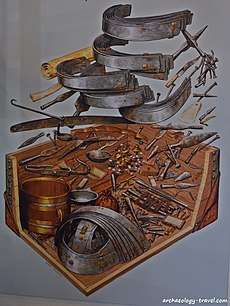Corbridge Hoard
The Corbridge Hoard is a hoard of mostly iron artefacts that was excavated in 1964 within the Roman site of Coria, next to what is now Corbridge, Northumberland, England (not to be confused with a hoard of gold coins found nearby in 1911).

It came from amongst the central range of administrative buildings in one of the early forts underlying the later Roman town and probably dates to between AD 122 and 138.[1]
Contents of the hoard
The contents (which included iron/steel, copper-alloy, lead-alloy, stone, glass, and organic items) were buried in an iron-bound, leather-covered chest, made of alder-wood planks fitted together with dovetails at the corners.
The most famous objects within were six upper and six lower half-units of 'lorica segmentata' armour which, although mis-matched, could represent as few as three whole cuirasses, or elements of twelve partial sets. It was this discovery that enabled Charles Daniels and H. Russell Robinson to understand how this type of armour should be reconstructed.[2] Prior to the discovery of the Hoard, "people knew there was the segmented armour, but we didn’t know how it was put together or how it was made".[3]
The Corbridge Hoard also contained bundles of spearheads still tied together with cord; artillery bolts; a sword scabbard; various tools and implements (including a pulley-block and a crusie lamp); items associated with carpentry, such as nails and joiner's dogs; a small wooden bucket or tankard. There were also fragmentary remains of feathers (possibly cushion stuffing or helmet plumes), wax writing tablets, and (almost uniquely in Roman Britain) fragments of papyrus.
All of the organic components in the Hoard (including the box itself) had been preserved by mineralization brought about by the rusting of its iron and steel contents.
The Hoard has been variously interpreted as material hurriedly concealed from attacking barbarians;[4] deliberately buried in order to accumulate verdigris and rust for medicinal purposes;[5] or detritus from clearing out a workshop when a garrison moved on from the site (and buried to deny the raw materials to an enemy[6]).
The full English Heritage report on the contents and interpretation of the hoard is now available through the Archaeology Data Service [7]
Display
Parts of the Hoard are on display at Corbridge Roman Site museum, whilst some other material from it is on display in the Great North Museum in Newcastle upon Tyne. From August 2012, the Hoard is in a new display at the Corbridge Roman site.[3] The exhibition includes a replica which will help visitors envisage how the armour once looked as well as a film showing footage never before shown in public of the excavation of the hoard as it was dug up from the trench in 1964.
See also
- Corbridge Lanx
- List of hoards in Britain
Notes
- (Allason-Jones and Bishop 1988)
- (Robinson 1975)
- Carmichael, Kim (2012-08-01). "Rare Roman treasure goes on display at Corbridge Roman Town - GALLERY". The Journal. Retrieved 2012-08-02.
- (Daniels 1968:126)
- (Davies 1970)
- Manning 1972:241-2
- Allason-Jones, L., Bishop, M. (1988) Excavations at Roman Corbridge: The Hoard. English Heritage.
References
- Allason-Jones L. and Bishop, M.C. 1988: Excavations at Roman Corbridge: the Hoard, HBMCE Archaeological Report 7, London. ISBN 9781848022010
- Daniels, C.M. 1968: "A hoard of iron and other materials from Corbridge" Archaeologia Aeliana Series 4, 46, 115-26
- Davies, R.W. 1970: "A note on the hoard of Roman equipment buried at Corbridge" Durham University Journal, 177-80
- Macdonald, G., 1912: "The Corbridge gold find of 1911", Journal of Roman Studies 2, 43-83
- Manning, W.H. 1972: "Iron work hoards in Iron Age and Roman Britain", Britannia 3, 224-50
- Robinson, H.R. 1975: The Armour of Imperial Rome, (London)